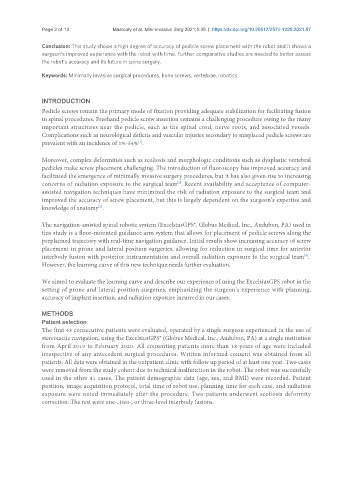Page 336 - Read Online
P. 336
Page 2 of 12 Maalouly et al. Mini-invasive Surg 2021;5:35 https://dx.doi.org/10.20517/2574-1225.2021.57
Conclusion: This study shows a high degree of accuracy of pedicle screw placement with the robot and it shows a
surgeon’s improved experience with the robot with time. Further comparative studies are needed to better assess
the robot’s accuracy and its future in spine surgery.
Keywords: Minimally invasive surgical procedures, bone screws, vertebrae, robotics
INTRODUCTION
Pedicle screws remain the primary mode of fixation providing adequate stabilization for facilitating fusion
in spinal procedures. Freehand pedicle screw insertion remains a challenging procedure owing to the many
important structures near the pedicle, such as the spinal cord, nerve roots, and associated vessels.
Complications such as neurological deficits and vascular injuries secondary to misplaced pedicle screws are
prevalent with an incidence of 1%-54% .
[1]
Moreover, complex deformities such as scoliosis and morphologic conditions such as dysplastic vertebral
pedicles make screw placement challenging. The introduction of fluoroscopy has improved accuracy and
facilitated the emergence of minimally invasive surgery procedures, but it has also given rise to increasing
[2]
concerns of radiation exposure to the surgical team . Recent availability and acceptance of computer-
assisted navigation techniques have minimized the risk of radiation exposure to the surgical team and
improved the accuracy of screw placement, but this is largely dependent on the surgeon’s expertise and
knowledge of anatomy .
[3]
The navigation-assisted spinal robotic system (ExcelsiusGPS®, Globus Medical, Inc., Audubon, PA) used in
this study is a floor-mounted guidance arm system that allows for placement of pedicle screws along the
preplanned trajectory with real-time navigation guidance. Initial results show increasing accuracy of screw
placement in prone and lateral position surgeries, allowing for reduction in surgical time for anterior
interbody fusion with posterior instrumentation and overall radiation exposure to the surgical team .
[4]
However, the learning curve of this new technique needs further evaluation.
We aimed to evaluate the learning curve and describe our experience of using the ExcelsiusGPS robot in the
setting of prone and lateral position surgeries, emphasizing the surgeon’s experience with planning,
accuracy of implant insertion, and radiation exposure incurred in our cases.
METHODS
Patient selection
The first 43 consecutive patients were evaluated, operated by a single surgeon experienced in the use of
stereotactic navigation, using the ExcelsiusGPS® (Globus Medical, Inc., Audubon, PA) at a single institution
from April 2019 to February 2020. All consenting patients more than 18 years of age were included
irrespective of any antecedent surgical procedures. Written informed consent was obtained from all
patients. All data were obtained in the outpatient clinic with follow up period of at least one year. Two cases
were removed from the study cohort due to technical malfunction in the robot. The robot was successfully
used in the other 41 cases. The patient demographic data (age, sex, and BMI) were recorded. Patient
position, image acquisition protocol, total time of robot use, planning time for each case, and radiation
exposure were noted immediately after the procedure. Two patients underwent scoliosis deformity
correction. The rest were one-, two-, or three-level interbody fusions.

